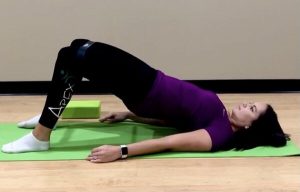Diastasis rectus abdominus (DRA), aka the “mommy belly,” is something that a lot of moms have experienced. For most, a DRA looks like a “bulge” running vertically down the middle of their belly. It may also look like a “tent” in the middle of your abdomen when you squeeze your core muscles or exercise. Although DRA is usually considered a cosmetic issue by most medical providers, it can also have functional implications in your body as well.
What Is Diastasis Rectus Abdominus?
Everybody has two rectus abdominus muscles, otherwise known as the “six-pack muscles,” that run vertically down the middle of your abdomen and are connected by body tissue called fascia. As the belly grows during pregnancy, the tissue connecting the two muscles is stretched, causing a space between them. DRAs are very common during pregnancy, and nearly every expecting mom will have one by her 3rd trimester. Luckily, by three months post-partum most DRAs will resolve on their own. However, for around 30% of new moms this split will remain, causing the “mommy belly” we’ve all heard about.
Although DRAs are usually thought of as a cosmetic issue, they can cause other problems in our body as well. Core weakness is common with diastasis rectus abdominus, and when your core muscles are weak, you may experience other issues such as lower back pain, abdominal pain, or urinary incontinence. With that being said, a DRA is definitely more than just a “cosmetic issue” as it is often dismissed by my medical professionals.
How To Fix “Mommy Tummy” at Home
The good thing is, there are things you can do on your own to fix your DRA! Below are a few at-home tips I like to give my patients who have a diastasis rectus abdominus.
1. Exercise
The number one thing you can do to decrease your DRA is to strengthen your core muscles. By improving the strength of your abdominal muscles, you can help reduce both the width and depth of your abdominal split. Here are a few of my favorites:
Simple Core Activation

It’s important to learn how to correctly activate your core muscles when dealing with a DRA. The easiest way is to start by placing your fingertips just inside of your hip bones at your lower abdomen. Next, gently pull your belly button back to your spine as if trying to button tight jeans. When you do this, you should feel a small “lift” of the muscle underneath your fingers. Do this 10 times, holding each one for 5-10 seconds.
Bridge

The bridge is a favorite exercise of many in the fitness world. Start by laying on your back with knees bent and feet on the floor. Gently tighten your core and lift your hips into the air by pushing into both of your feet. Hold each bridge for 5 seconds, and do them 10 times.
Kegel
Yes, kegels can help reduce your “mommy belly!” Your core muscles and pelvic floor muscles work very closely together, so by strengthening one, you are helping the other. To do a kegel, imagine as if you are trying to stop your flow of urine by pulling your lower pelvic muscles up and in to your body. Do this 10 times, holding each for 5 seconds.
Bird Dog

I love yoga-based exercises to help improve core strength and decrease the size of a DRA. To do a bird dog, first start on your hands and knees. Gently tighten your abdominal muscles, and lift one arm forward while extending the opposite leg back. Do this 10 times, alternating from side to side.
2. Mind Your Breathing
You may find that when you lift your baby in the car seat, you hold your breath. Or, while carrying in all of those grocery bags, you don’t breath until you put them down. This may not seem like a big deal, but if you have a DRA, it is! Holding your breath increases pressure in your abdomen which may keep pushing your DRA out. You can avoid a lot of strain through your abdomen by making sure you are breathing during more vigorous activities.
3. Slowly Increase Activity
Although it may seem tempting to jump all in with exercise post-partum, it’s best to go slow and start with the basics. When you jump into activity before your body is ready, you may be straining your DRA, which can keep it from improving. Start slow: walking, swimming, basic strengthening exercises like those listed above (all which can be done at home), to make sure your body is safe and ready for increased activity.
What to Do If You Don’t See Improvement
Unfortunately, sometimes those stubborn DRAs need a little more help to close. Luckily, there are so many professionals who are trained to help! If you try at-home exercises and aren’t seeing any improvement, it is probably time to seek out a local women’s health physical therapist or post-partum exercise specialist. These professionals can provide an assessment and help develop a personalized program to give your body the help it needs. Sometimes our body just needs that extra assistance to give us the results we want.
A diastasis rectus abdominus or “mommy belly” is a common problem that can be the main culprit of numerous post-partum issues. The good thing is, there are things you can do about it! Starting with these at home, easy exercises can help “close the gap” and get your body functioning at its best!
















